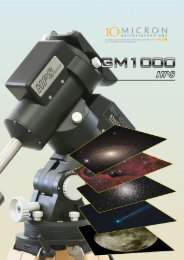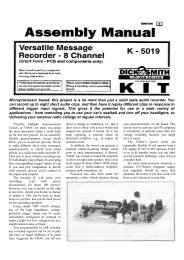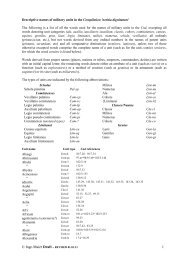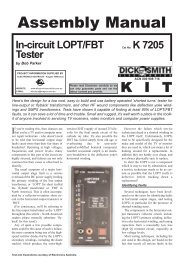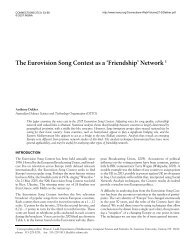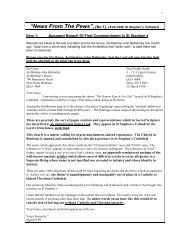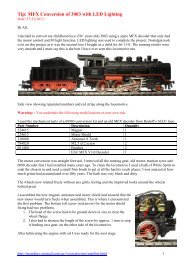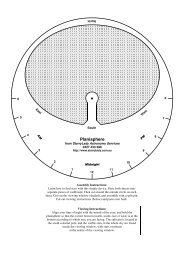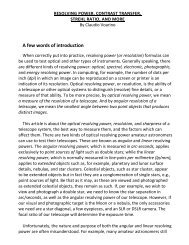Create successful ePaper yourself
Turn your PDF publications into a flip-book with our unique Google optimized e-Paper software.
USER’S GUIDE<br />
DRAFT<br />
October 2005<br />
AGNPS – UM Version 4.02<br />
Agricultural Non Point Source Pollution Model<br />
using the<br />
<strong>USLE</strong>-M<br />
(not to be confused with the M<strong>USLE</strong>)<br />
P.I.A. Kinnell<br />
University of Canberra<br />
Canberra<br />
AUSTRALIA<br />
AGNPS-UM User’s Guide I
Disclaimer<br />
The software to which this User’s Guide applies is used entirely at the user’s own risk.<br />
While every effort has been made to ensure that the software is error free, the<br />
software is used by the recipient upon the express understanding that the developer<br />
makes no warranties, expressed or implied, concerning the accuracy, completeness,<br />
reliability or suitability for any one purpose, and that the developer shall be under no<br />
liability to any person by reason of any use made thereof.<br />
Contents<br />
page<br />
<strong>USLE</strong>-M Theory<br />
<strong>USLE</strong>-M erosivity factor 1<br />
<strong>USLE</strong>-M soil erodibility 3<br />
<strong>USLE</strong>-M Crop and crop management factor 4<br />
Predicting erosion via the <strong>USLE</strong>-M 5<br />
The <strong>USLE</strong>-M lite (uses <strong>USLE</strong> C and P factors directly) 7<br />
Caution (<strong>USLE</strong>-M lite NOT direct replacement for <strong>USLE</strong>-M) 8<br />
AGNPS-UM software 9<br />
Installing and running the software 10<br />
Erosion model options 11<br />
Graphic output 13<br />
Output data files 13<br />
Example data 14<br />
Literature 14<br />
Erosion on a dry catchment/watershed – AGNPS-UM takes account of moisture status<br />
.<br />
AGNPS-UM User’s Guide II
AGNPS - UM<br />
AGNPS, the Agricultural Non Point Source Pollution model, was developed in the USA to<br />
predict the effect of land use on the quality of water discharged from catchments or<br />
watersheds. It is an event based model and uses the Universal Soil Loss Equation (<strong>USLE</strong>)<br />
to predict erosion within grid cells on hillsides. The <strong>USLE</strong> was not designed to predict<br />
event erosion. A modification of the <strong>USLE</strong> called the <strong>USLE</strong>-M can do this better. AGNPS-<br />
UM uses the <strong>USLE</strong>-M instead of the <strong>USLE</strong>.<br />
<strong>USLE</strong>-M theory<br />
The <strong>USLE</strong>-M is a variant of the Universal Soil Loss Equation (<strong>USLE</strong>) and the Revised<br />
version of it (R<strong>USLE</strong>). The <strong>USLE</strong> is an empirical model that predicts average annual<br />
erosion (A) in terms of 6 factors;<br />
A = R K L S C P (1)<br />
where R is the rainfall-runoff factor, K is the soil erodibility factor, L is the slope length<br />
factor, S is the slope gradient factor, C is the crop and crop management factor and P is the<br />
supporting practices factor. The R factor is the annual average value of the event erosivity<br />
factor (Re) where<br />
Re = E I30 (2)<br />
where E is the total kinetic energy of the rainfall event and I30 is the maximum 30-minute<br />
rainfall intensity (maximum intensity using a 30-minute time frame).<br />
<strong>USLE</strong>-M event erosivity factor – the QREI30 index<br />
Although the <strong>USLE</strong> was not designed to predict event erosion, it follows from Eqs. 1 and 2<br />
that<br />
Ae = [E I30]e Ke L S Ce Pe (3)<br />
where the subscript e indicates factor values that vary between rainfall events. The <strong>USLE</strong>-<br />
M uses QREI30, where QR is the runoff ratio for the area being considered, instead of the<br />
EI30 for the event erosivity factor.<br />
Because the <strong>USLE</strong> is an empirical model, changing the event erosivity index from EI30 has<br />
consequences. The soil erodibility factor must be changed because it has units of soil loss<br />
per unit of the erosivity factor. The crop and support practice factors must also be changed<br />
to account for the movement of the runoff effect which they normally deal with to the<br />
erosivity factor. Consequently, the <strong>USLE</strong>-M is given by<br />
Ae = [QR E I30]e KeUM L S CeUM PeUM (4)<br />
where the subscript UM indicates factors that differ in value from the factors used in the<br />
<strong>USLE</strong>.<br />
While the <strong>USLE</strong>-M is an empirical model, the QREI30 index has a physical basis. The<br />
sediment discharged with runoff is given by the product of runoff and sediment<br />
AGNPS-UM User’s Guide 1
predicted soil loss (t/ha)<br />
concentration and the QREI30 index results from considering that the sediment<br />
concentration for an event is dependent the energy per unit quantity of rain and a measure<br />
of the maximum rainfall intensity since a large proportion of the runoff is generated during<br />
time when the rainfall intensity is high. The energy per unit quantity of rain is given by E<br />
divided by rainfall amount and I30 is a measure of the maximum rainfall intensity. Thus<br />
ReUM = Qe (E / event rainfall amount) I30 (5)<br />
where Qe is the amount of runoff for the event. However<br />
QR = Qe / event rainfall amount (6)<br />
so that<br />
ReUM = QR E I30 (7)<br />
On a bare fallow area (Ce = CeUM = 1) with cultivation up and down the slope (Pe = PeUM =<br />
1), event erosion is give by<br />
Ae( CeUM = PeUM = 1) = b [QR E I30]e (8)<br />
where b = KeUM L S. Figure 1 provides a comparison between Eq. 8 and the <strong>USLE</strong><br />
equivalent<br />
Ae( Ce = Pe = 1) = b [E I30]e (9)<br />
where b = Ke L S.<br />
100<br />
10<br />
1<br />
0.1<br />
0.01<br />
R e = EI 30<br />
0.01 0.1 1 10 100<br />
observed soil loss (t/ha)<br />
Eff ln = 0.084<br />
Figure 1. Relationships between observed and predicted event soil loss for plot 10<br />
(bare fallow) in experiment 1 at Morris, MN when predicted = bRe where Re is EI30<br />
and QREI30. Effln is the Nash-Sutcliffe (1970) efficiency factor for the ln transforms of<br />
the data and reflects the amount of variation from the 1:1 lines shown in these figures.<br />
NB. This analysis takes no account of short term variations in K or KUM.<br />
AGNPS-UM User’s Guide 2<br />
predicted soil loss (t/ha)<br />
100<br />
10<br />
1<br />
0.1<br />
0.01<br />
R e = Q REI 30<br />
0.01 0.1 1 10 100<br />
observed soil loss (t/ha)<br />
Eff ln = 0.738
The runoff and soil loss plot used in this comparison is part of the <strong>USLE</strong> data base. The<br />
total loss from the plot was 374 t ha -1 from 80 events over 10 years. The top 5 events<br />
produced 177 t ha -1 . The <strong>USLE</strong> (Eq. 9) predicted 123 t ha -1 (-31% error) while the <strong>USLE</strong>-M<br />
(Eq. 8) predicted 164 t ha -1 (-7% error). The 10 events producing the lowest soil loss<br />
contributed 0.83 t ha -1 . The <strong>USLE</strong> predicted 25 t ha -1 for these events, the <strong>USLE</strong>-M 1.12 t<br />
ha -1 . The Nash-Sutcliffe (1970) efficiency factor (Effln) provides a measure of a model’s<br />
performance. A value of 1.0 is achieved by the perfect model. Effln for the QREI30 index is<br />
0.734 while the EI30 index gives 0.084. A value of zero means that the model predicts no<br />
better than if the mean of the independent variable (EI30 or QREI30) is used.<br />
<strong>USLE</strong>-M Soil Erodibility (KUM)<br />
A noted above, the soil erodibility factor for the <strong>USLE</strong>-M (KUM) differs from that of the<br />
<strong>USLE</strong> because the soil erodibility factor in both models has units of soil loss per unit of the<br />
erosivity factor. Because Ce = CeUM = Pe = PeUM = 1.0 when the area being eroded is bare<br />
fallow with cultivation up and down the slope, the annual average value of the <strong>USLE</strong>-M<br />
soil erodibility factor can be determined from data such as shown in Figure 1. The general<br />
equation for determining average annual soil erodibility for any given event erosivity index<br />
(Xe) is<br />
N<br />
ΣAe1<br />
e=1<br />
K(Xe) = ____________ (10)<br />
N<br />
Σ Xe<br />
e=1<br />
where Ae1 is event soil loss on what is called “the unit plot”, bare fallow with cultivation up<br />
and down the slope on an 22.13 m long slope with a gradient of 9 %, and N is the number<br />
of events used to determine K(Xe). Since the <strong>USLE</strong>-M uses the <strong>USLE</strong> L and S factor<br />
values, event soil losses obtained on areas of bare fallow with cultivation up and down the<br />
slope that are not 22.13 m long on a 9 % slope can be converted to unit plot values using<br />
the <strong>USLE</strong> or the R<strong>USLE</strong> L and S factors.<br />
L = (λ / 22.13 ) m (11)<br />
where λ is the slope length and m is a power that is related to the ratio of rill and interrill<br />
erosion. In the <strong>USLE</strong><br />
m = 0.6 slope > 10% (12a)<br />
m = 0.5 5 - 10% (12b)<br />
m = 0.4 3 - 5% (12c)<br />
m = 0.3 1 - 3% (12d)<br />
m =.0.2 < 1% (12e)<br />
In the R<strong>USLE</strong>,<br />
m = β / ( 1+ β) (13)<br />
where, for soil that is moderately susceptible to rilling<br />
AGNPS-UM User’s Guide 3
β = (sin θ / 0.0896) / [3.0 (sin θ ) 0.8 + 0.56] (14)<br />
where θ = angle to horizontal.<br />
The slope gradient factor (S) for the <strong>USLE</strong> is given by<br />
S = 65.4 sin 2 θ + 4.56 sin θ + 0.654 (15)<br />
but was replaced by<br />
S = 10.8 sin θ + 0.03 slopes < 9% (16a)<br />
S = 16.8 sin θ - 0.50 slopes ≥ 9% (16b)<br />
in the R<strong>USLE</strong> because Eq. 15 overestimated erosion on high slope gradients.<br />
<strong>USLE</strong>-M Crop and Crop Management (CUM)<br />
As indicated in Eq. 4, the <strong>USLE</strong>-M Crop and Crop Management factor (CUM) values differ<br />
from the <strong>USLE</strong> Crop and Crop Management factor (C) values because the runoff effect that<br />
is included in C is moved to the erosivity factor when the erosivity factor is based on runoff<br />
from the vegetated area. Table 1 shows annual average values of the Crop and Crop<br />
Management factor for the <strong>USLE</strong>-M and the <strong>USLE</strong> for crops determined from erosion<br />
experiments at various locations in the USA.<br />
Table 1. Examples of CUM values for crops at various USA locations<br />
Location Crop CUM CU CUM/CU CU/CUM<br />
Bethany, Missouri alfalfa 0.008 0.002 4.0 0.250<br />
corn 0.674 0.628 1.1 0.932<br />
corn/meadow/wheat 0.188 0.106 1.8 0.564<br />
Clarinda, Iowa corn 0.634 0.316 2.0 0.498<br />
corn/oats/meadow 0.424 0.168 2.5 0.396<br />
Guthrie, Oklahoma cotton 2.435 1.357 1.8 0.557<br />
Bermuda grass 0.064 0.002 32.3 0.031<br />
wheat/clover/cotton 0.913 0.344 2.7 0.377<br />
LaCrosse, Wisconsin corn 0.527 0.469 1.1 0.890<br />
Madison, S.Dakota corn(ploughed) 0.486 0.337 1.4 0.693<br />
corn(mulch till) 0.384 0.250 1.5 0.651<br />
Morris, Minnesota corn 0.520 0.434 1.2 0.835<br />
meadow/corn/oats 0.046 0.010 4.6 0.217<br />
Presque Isle, Maine potatoes 0.634 0.316 2.0 0.498<br />
AGNPS-UM User’s Guide 4
These values were determined using<br />
and<br />
N<br />
Σ Ae..c<br />
e=1<br />
C = ———————— (17)<br />
N<br />
LS K Σ (EI30)e<br />
e=1<br />
N<br />
Σ Ae.c<br />
e=1<br />
CUM = ————————— (18)<br />
N<br />
LS KUM Σ (QREI30)e<br />
e=1<br />
where K and KUM were determined from data from bare fallow plots at the respective sites.<br />
Predicting erosion via the <strong>USLE</strong>-M<br />
While the <strong>USLE</strong> is an empirical model whose factor values were originally determined<br />
from erosion experiments, procedures for determining factor values from soil, crop and<br />
management data have been developed to facilitate the prediction of erosion using the<br />
<strong>USLE</strong>. For example, an equation was developed to calculate soil erodibility in the <strong>USLE</strong><br />
for soils that contain less than 70% silt in the USA ,<br />
K = [2.1 10 -4 (12-OM) M 1.14 + 3.2(s-2) + 2.5(p-3)]/100 (19)<br />
where K is in customary US units, OM is percent organic matter, M depends on the soil<br />
texture, s is soil structure class, and p is permeability. Other equations exist for soils in<br />
other geographic locations such as Hawaii.<br />
The <strong>USLE</strong>-M soil erodibility factor is greater than the <strong>USLE</strong> soil erodibility factor because<br />
of the inclusion of QR, the runoff ratio, in the event erosivity index. KUM is related to K via<br />
the inverse of the runoff ratio for bare fallow and cultivation up and down the slope (QR1)<br />
through a coefficient (kKUM)<br />
so that<br />
N<br />
Σ (EI30)e<br />
e=1<br />
kK.UM = ————— (20)<br />
N<br />
Σ (QR1EI30)e<br />
e=1<br />
KUM = kK.UM K (21)<br />
AGNPS-UM User’s Guide 5
In most cases, soil erodibility is considered to relatively constant in comparison to<br />
variations in C and P so that, in most cases,<br />
can be used.<br />
KUMe = KUM (22)<br />
The gross runoff ratio for runoff producing events (GRRrope) is given<br />
N<br />
Σ Qe.<br />
e=1<br />
GRRrope = ——— (23)<br />
N<br />
Σ Be<br />
e=1<br />
where Be is event rainfall and data obtained from the <strong>USLE</strong> runoff and soil loss plot data<br />
base shows that kKUM can be estimated by<br />
kK.UM = (GRRrope) - 0.79 (24)<br />
Given an ability to predict event runoff from event rainfall, it is possible to determine<br />
GRRrope and convert K to KUM.<br />
CUM values can be calculated from C values through<br />
where<br />
As with kK.UM,<br />
CUM = C kC.UM / kK.UM (25)<br />
N<br />
Σ (EI30)e<br />
e=1<br />
kC.UM = ————— (26)<br />
N<br />
Σ (QREI30)e<br />
e=1<br />
kC.UM = (GRRrope) - 0.79 (27)<br />
when GRRrope is known for the vegetated condition.<br />
A similar approach can be used to determine PUM from P.<br />
Theortically, it follows from Eqs. 20, 25 and 26 that event values of CUM and PUM can be<br />
determined from event values of C and P by multiplying the relevant <strong>USLE</strong> factor values<br />
by ratio of QR1e to QRe when QRe > 0. However, that assumes that the runoff effect on<br />
erosion under non unit plot conditions is considered correctly within the determination of<br />
Ce and Pe values. That assumption may not be correct given that procedures for determining<br />
short term values of C and P may subjective and not give proper consideration as to how<br />
AGNPS-UM User’s Guide 6
unoff and sediment concentration influence erosion. For example, the <strong>USLE</strong>/R<strong>USLE</strong> uses<br />
period (fortnightly) C values and it is logical to suggest that Ce values during a fortnightly<br />
period are equal to the period C value. However, this would produce CeUM values that vary<br />
between events with the ratio of QR1e to QRe where as the effect of the crop on sediment<br />
concentration should remain relatively constant during that period. Appropriate rules for<br />
determining CeUM values from crop morphology and management have yet to be developed.<br />
The <strong>USLE</strong>-M lite<br />
Procedures exist for determining short term values of C and P in the R<strong>USLE</strong> but similar<br />
procedures have yet to be developed to determine CeUM and PeUM. However, despite Eq. 4,<br />
an approach does exist that enables short term values of C and P to be used directly when<br />
the QREI30 is used as the event erosivity index.<br />
The <strong>USLE</strong>/R<strong>USLE</strong> model is based on the prediction of erosion for the unit plot condition<br />
(22.1m long slope, 9% gradient, bare fallow with cultivation up and down the slope) and<br />
the L, S, C and P factors are ratios with respect to the unit plot. Thus, the approach is in<br />
effect a two staged one; the prediction of erosion for the unit plot condition where<br />
A1 = R K (28)<br />
where A1 is the annual average erosion on the unit plot, R is the annual average erosivity<br />
factor and K is the average annual soil erodibility, followed by<br />
A = A1 L S C P (29)<br />
where A is the average annual erosion on an area that differs from the unit plot is some<br />
way. In the context of a rainfall event, these two equations become<br />
and<br />
A1e = Re Ke (30)<br />
Ae = A1e L S Ce Pe (31)<br />
where Re = EI30. As indicated above, KUMe ≠ Ke, CUMe ≠ Ce, PUMe ≠ Pe. However, CUMe ≠ Ce<br />
and PUMe ≠ Pe only applies when the runoff values used to determine QR in Eq. 4 are those<br />
associated with an area that is vegetated and cultivation is not up and down the slope. Thus,<br />
if the QREI30 index is used to predict erosion for the bare fallow cultivation up and down<br />
the slope condition (C = P = 1), then<br />
Ae(C = P = 1) = k KUMe [QR1EI30]e (32)<br />
where k = LS, and values for C and P generated by the <strong>USLE</strong> or the R<strong>USLE</strong> can be used to<br />
give<br />
Ae = [QR1EI30]e KUMe L S Ce Pe (33)<br />
where QR1 is the runoff ratio for the bare fallow and cultivation up and down the slope<br />
condition. The procedures for determining short term values for C and P in the R<strong>USLE</strong><br />
AGNPS-UM User’s Guide 7
documentation (Renard et al., 1997) can thus be used as a guide to determining Ce and Pe<br />
values for use in Eq. 31.<br />
The model described by Eq. 33 is called the <strong>USLE</strong>-M lite to distinguish it from that<br />
described by Eq. 4.<br />
Caution<br />
The <strong>USLE</strong>-M lite is NOT a direct replacement for the <strong>USLE</strong>-M in respect to<br />
modelling event erosion.<br />
The <strong>USLE</strong>-M lite, like the <strong>USLE</strong>, is based on the assumption that erosion occurs when C ≠<br />
1 and P ≠ 1 whenever erosion occurs when C = 1 and P = 1. Normally, there are many<br />
occasions where erosion occurs on a bare fallow area but not on a vegetated one, and there<br />
may be occasions where erosion occurs on a vegetated area but not on a bare fallow area.<br />
Figure 2 shows the result predicting event soil losses by multiplying observed event soil<br />
losses from an adjacent bare fallow plot by period C values for conventional corn at<br />
Clarinda, Iowa over a 7 year period.<br />
predicted event soil loss (T/A)<br />
100.000<br />
10.000<br />
1.000<br />
0.100<br />
0.010<br />
0.0001 0.0010 0.0100 0.1000 1.0000 10.0000 100.0000<br />
observered event soil loss + 0.0001 (T/A)<br />
Figure 2. Relationship between event soil losses predicted by multiplying event soil<br />
losses from a nearby bare fallow plot by R<strong>USLE</strong> period Soil Loss Ratios (fortnightly C<br />
factor values) and event soil losses observed for conventional corn at Clarinda, Iowa<br />
plus 0.0001 tons acre-1 to enable predicted losses to be displayed when observed losses<br />
are zero.<br />
The total observed and predicted amounts over the 7 years were in close agreement (130<br />
tons acre -1 observed, 131 tons acre -1 predicted) but 12 % of the predicted amount was<br />
contributed by events that produced zero erosion on the cropped plot. Because the <strong>USLE</strong>-M<br />
event erosivity index is based on runoff from areas where C ≠ 1 and P ≠ 1, the <strong>USLE</strong>-M is<br />
more appropriately applied to modelling event erosion than the <strong>USLE</strong>-M lite.<br />
AGNPS-UM User’s Guide 8
AGNPS-UM software<br />
The AGNPS-UM software predicts erosion in customary US units (tons/acre) in grid cells<br />
within a catchment or watershed given 3 ascii GIS files and a <strong>USLE</strong>/<strong>USLE</strong>-M attribute data<br />
file. The GIS files are grid cell files for elevation, soils and land use and the user needs to<br />
know the grid cell coordinates of the catchment or watershed outlet and the cell size<br />
(metres). The cell size should be of the order of 100 m or less. The acsii files can have a<br />
GRASS, ARCH/INFO or MAPINFO format. The ascii files are used in conjunction with<br />
TOPAZ (http://duke.usask.ca/~martzl/topaz) to identify the catchment or watershed<br />
boundary, generate an artificial stream network, as well as determine grid cell slope<br />
gradient and flow direction using the D8 method.<br />
The software can handle grids of up to 1000 by 1000 (1 million) cells. The restriction<br />
of 32,000 cells that applies to the original AGNPS executables does not apply to the<br />
AGNPS-UM software.<br />
The <strong>USLE</strong>/<strong>USLE</strong>-M attribute data file is generated by the user to contain Ke, Ce, Pe values<br />
for the <strong>USLE</strong> and KeUM, CeUM, PeUM values for the <strong>USLE</strong>-M for the relevant soils and<br />
landuses. The units for these data are customary US units. Table 2 provides an example of<br />
the <strong>USLE</strong>/<strong>USLE</strong>-M attribute data file.<br />
Table 2. Example of the AGNPS/<strong>USLE</strong>-M data file<br />
- Back Ck<br />
Part of Chaffey Dam catchment<br />
2.80 rain(inch)<br />
62.0 EI30(100ft-ton-inch/A-h)<br />
6 soils K texture CN bare ident<br />
1 0.38 3 80 dummy clay<br />
3 0.30 2 75 Alluvial<br />
4 0.30 3 75 Black Earth<br />
5 0.28 3 70 Krasnozem<br />
6 0.38 2 85 Lithosols<br />
7 0.40 1 80 Solodics<br />
5 luses C P fert avN avP man's n s.cond COD ident<br />
1 0.05 1.0 0 00 00 0.050 0.01 60 dummy = native pasture (outside)<br />
3 0.003 1.0 0 00 00 0.050 0.01 60 undisturbed forest<br />
5 0.05 1.0 0 00 00 0.050 0.01 60 native pasture<br />
6 0.10 0.5 2 60 60 0.060 0.15 60 improved pasture<br />
7 0.15 0.5 2 65 65 0.250 0.05 80 crop<br />
6 soils Kum ident<br />
1 0.50 dummy clay<br />
3 0.47 Alluvial<br />
4 0.40 Black Earth<br />
5 0.37 Krasnozem<br />
6 0.60 Lithosols<br />
7 0.88 Solodics<br />
5 luses Cum Pum CNadj ident<br />
1 0.111 1.0 0.80 dummy = native pasture (outside)<br />
3 0.03 1.0 0.70 undisturbed forest<br />
5 0.111 1.0 0.80 native pasture<br />
6 0.2 0.5 0.85 improved pasture<br />
7 0.28 0.5 0.87 crop<br />
USDA Curve Numbers (CN) are used for runoff prediction in AGNPS and CN values for<br />
bare soil and cultivation up and down the slope are also entered into the <strong>USLE</strong>/<strong>USLE</strong>-M<br />
attribute data file together with CN conversion coefficients which are used to convert CNs<br />
for bare soil to CNs for the vegetated areas. Runoff prediction from vegetated areas is based<br />
on the assumption that the ratio of CN vegetated to CN bare + cultivation up and down the<br />
slope does not vary between soils. Event EI30 and rainfall amount are also entered via the<br />
<strong>USLE</strong>/<strong>USLE</strong>-M attribute data file. In addition to the <strong>USLE</strong>/<strong>USLE</strong>-M attribute data inputs,<br />
AGNPS-UM User’s Guide 9
the <strong>USLE</strong>/<strong>USLE</strong>-M attribute data file contains data normally associated with AGNPS such<br />
as Manning’s n, data on fertilizer use and release etc. Users should consult the AGNPS<br />
User Manual which can be obtained via http://www.sedlab.olemiss.edu/agnps/archives.html<br />
in relation to the values for these data.<br />
The software package contains set of example data files, bkckelev.dat (elevation),<br />
bkckluse.dat (landuse), bkcksoil (soil) and bkckcat.dat (<strong>USLE</strong>/<strong>USLE</strong>-M attribute data).<br />
Table 2 shows the contents of bkckcat.dat and agnps.dat. agnps.dat is the file that is used by<br />
the software when generating the data input files that the AGNPS-UM software uses during<br />
the calculation phase. The contents of agnps.dat can replaced by the contents of bkckcat.dat<br />
or any other appropriate <strong>USLE</strong>/<strong>USLE</strong>-M attribute data file when necessary. agnps.dat can<br />
contain global data that is not relevant to catchment or watershed being modelled. The<br />
software will crash if relevant data is missing.<br />
A facility exists in the software package to generate new agnps.dat files. However, it is<br />
easier to edit existing ones. These files are space deliminated.<br />
Installing and running the software package<br />
The software package is contained in a .ZIP file which will set up the appropriate<br />
directories/folders when the software is extracted using directory/folder names option is<br />
flagged.<br />
The program execution file is AGUMxxx.exe where xxx is the version number.<br />
The operations of the program are controlled through a menu.<br />
(1) Set up GIS and attribute files<br />
(2) Generate grid cells and flow network<br />
(3) Generate AGNPS input and output data files<br />
(4) View catchment graphic<br />
(5) Stitch GIS outputs into larger area<br />
(6) END<br />
(7) Information about running example<br />
(1) Set up GIS and attribute files is the first step. When this step is invoked, the user<br />
specifies the GIS files to be used by the program. The user needs to be aware of the format<br />
of these files and ensure that they meet the format that the software will accept (GRASS,<br />
ARCH/INFO, MAPINFO). Elevation data can be stored with various levels of precision.<br />
The user will be asked to provide a factor that will convert the GIS elevation data to metres.<br />
The software will respond with data on maximum and minimum elevations in metres and<br />
the user can return to enter a new conversion factor if necessary. The user should note the<br />
maximum and minimum elevations for use later. All three GIS files (elevation, landuse,<br />
soils) must be nominated in response to selecting Set up GIS and attribute files unless they<br />
have been dealt with previously. If a new set of landuses is the only change, then its GIS<br />
file is the only one that needs to be processed.<br />
AGNPS-UM User’s Guide 10
The facility to generate the agnps.dat file is included in Set up GIS and attribute files. As<br />
noted earlier, the better option is to edit and store an existing one so that this facility may be<br />
seldom used. If a new agnps.dat file is generated via Set up GIS and attribute files and<br />
needs to be stored in case it gets overwritten, then the user will need to use Windows<br />
facilities to do this.<br />
(2) Generate grid cells and flow network causes TOPAZ to generate grid cells and<br />
the flow network from the elevation file. During this process, the user has to enter data on<br />
cell size, valid elevations ( recall maximum and minimum elevations given during Set up<br />
GIS and attribute files), the grid cell coordinates of the outlet cell, and the critical source<br />
area (CSA) in hectares for channel initiation. TOPAZ initiates a channel where ever the<br />
upslope area exceeds the CSA.<br />
(3 ) Generate AGNPS input and output data files gives the user the choice of a<br />
number of models to run.<br />
(1) The <strong>USLE</strong> with L via Desmet and Govers (1996)<br />
(2) The <strong>USLE</strong> with L via Kinnell (2004)<br />
(3) The <strong>USLE</strong>-M lite<br />
(4) The <strong>USLE</strong>-M<br />
(1) The <strong>USLE</strong> with L via Desmet and Govers (1996)<br />
The L factor in the <strong>USLE</strong> is designed to work over an area whose length begins where<br />
overland flow starts. A grid cell often is an area some distance downslope from where<br />
runoff starts. In such circumstances, a grid cell receives runoff from upslope and the<br />
erosion within that cell depends on the length of the cell and the effective length of the<br />
upslope area. If the upslope area is rectangular and the same width as the cell, the slope<br />
effect length of the upslope area is the same as the physical slope length. However, this is<br />
not the case when the flow in through the upslope boundary of the cell comes from an area<br />
with some other shape. According to Desmet and Govers (1996), the effective slope length<br />
of the upslope area in all cases is given by the upslope area divided by the width of the<br />
boundary over which the runoff flows which is the width of the cell. Consequently, for a<br />
cell with coordinates i,j,<br />
( Ai,j-in + D 2 ) m+1 - Ai,j-in m+1<br />
Li,j = —————————— (32)<br />
D m+2 xi,j m λ1 m<br />
where Ai,j-in is the area (m 2 ) upslope of the cell, D is cell size (m), m is the coefficient used<br />
in the calculation of L, x is a factor that depends on direction of flow with respect to the<br />
orientation of the cell, and λ1 is the length of slope for the unit plot (22.13 m). The <strong>USLE</strong><br />
with L via Desmet and Govers (1996) uses Eq. 32 in the calculation of cell erosion.<br />
(2) The <strong>USLE</strong> with L via Kinnell (2004)<br />
With Eq. 32, if runoff does not enter from upslope, then Ai,j-in = 0 and Eq. 32 gives the<br />
same value as Eq. 11. Thus, cells adjacent to the boundary of the catchment or watershed<br />
AGNPS-UM User’s Guide 11
act essentially as isolated areas. However, it is possible that a cell somewhere in the<br />
catchment or watershed may not produce any runoff across its downstream boundary<br />
because it has a high infiltration capacity. Logically, Ai,j-in = 0 for the cell downslope of that<br />
cell and that condition can be set whenever the runoff coefficient for the uppslope area<br />
(QCi,j –in) is found to be zero. However, it is also logical to suggest that the effective upslope<br />
area (Ai,j-in.eff ) is less than the physical area (Ai,j-in) whenever QCi,j-in is less than the runoff<br />
coefficent of the area including the cell (QCi,j-all ) so that (Kinnell, 2005)<br />
where<br />
( Ai,j-in.eff + D 2 ) m+1 - Ai,j-in.eff m+1<br />
Li,j = ————————————— (33)<br />
D m+2 xi,j m λ1 m<br />
Ai,j-in.eff = Ai,j-in QCe.i,j-in / QCe.i,j-all (34)<br />
The <strong>USLE</strong> with L via Kinnell (2004) option calculates erosion using Eqs. 33 and 34.<br />
(3) The <strong>USLE</strong>-M lite<br />
Eqs. 33 and 34 are also fundamental to applying the <strong>USLE</strong>-M lite and the <strong>USLE</strong>-M to the<br />
prediction of erosion in grid cells. When runoff is generated uniformly over an area,<br />
QCe.i,j-all (Ai,j-in + D 2 ) m+1 - QCe.i,j-all Ai,j-in m+1<br />
LUMe i,j = ————————————————— (35)<br />
QRe.i,j-cell D m+2 xi,j m (22.13) m<br />
where QRe.i,j-cell is the runoff ratio for the cell. QRe.i,j-cell is the ratio of the volume of water<br />
discharged from the cell to the volume of rain water falling onto the cell. Because the<br />
volume of water discharged from the cell includes runon from upslope, it can have values<br />
greater than 1.0. QRe.i,j-cell occurs in Eq. 35 because the erosivity index for a cell is given by<br />
the product of QRe.i,j-cell and EI30. Runoff coefficents are ratios of rain and runoff volumes<br />
on the same area and consequently have values of 1.0 or less with Hortonian overland<br />
flow.When considered in the context of Ai,j-in.eff determined by Eq 34, Eq. 35 becomes<br />
QCe.i,j-all.eff (Ai,j-in.eff + D 2 ) m+1 - QCe.i,j-all.eff Ai,j-in.eff m+1<br />
LUMe i,j = ——————————————————————— (36)<br />
QRe.i,j-cell D m+2 xi,j m (22.13) m<br />
In the case of the <strong>USLE</strong>-L lite, QCe.i,j-all.eff is the runoff coefficient for the area including the<br />
cell when the whole area is considered to be bare fallow with cultivation up and down the<br />
slope,<br />
QCe.i,j-all.eff = [(QC1e.i,j-cell D 2 ) + (QC1e.i,j-in Ai,j-in.)] / (Ai,j-in + D 2 ) (37).<br />
where QC1e.i,j-cell is the runoff coefficient for the cell when C = P =1, and QC1e.i,j-in is the<br />
runoff coefficient for the upslope area when C = P = 1. Eq. 36 is Eq. 33 multiplied by<br />
QCe.i,j-all.eff / QRe.i,j-cell .<br />
AGNPS-UM User’s Guide 12
The <strong>USLE</strong>-M lite option predicts erosion using Eqs. 34, 36 and 37. It uses the KUM data in<br />
agnps.dat together with CN bare, K, C and P. It ignores the data for CUM, PUM, CNadj.<br />
(4) The <strong>USLE</strong>-M<br />
In the case of the <strong>USLE</strong>-M,<br />
QCe.i,j-all.eff = [(QCe.i,j-cell D 2 ) + (QCe.i,j-in Ai,j-in.)] / (Ai,j-in.eff + D 2 ) (38).<br />
Again, in the case of the <strong>USLE</strong>-M. Eq. 36 is Eq. 33 multiplied by QCe.i,j-all.eff / QRe.i,j-cell but<br />
QCe.i,j-all.eff is determined using Eq. 38 rather than Eq. 37.<br />
The <strong>USLE</strong>-M option predicts erosion using Eqs. 34, 36 and 38.<br />
Upon completion of the calculation of erosion within the catchment or watershed, the<br />
software will move directly to (4) View catchment graphic (see below)<br />
(4) View catchment graphic enables the user to view the model output using the<br />
GRAFIX utility that is part of the AGNPS v5 suite. The 5 letter catchment/watershed<br />
identity is used in this process followed by –dg for Desment and Govers (1996) L, -pk for<br />
Kinnell (2004) L, -ml for the <strong>USLE</strong>-M lite and –um for the <strong>USLE</strong>-M. Once the appropriate<br />
output is selected, GRAFIX produces an outline of the catchment. To view the graphic of<br />
cell erosion follow the following path;<br />
Variables<br />
Add Variable<br />
AGNPS Parameters<br />
Runoff and Soil Loss<br />
then use the Esc key to go back up the sequence. Then follow<br />
File<br />
Variable File<br />
Load Variables<br />
EROS.VAR<br />
Other variables such as slope gradient, K, C and sediment can be displayed using GRAFIX.<br />
GRAFIX enables the user to set up graphical displays of whatever variable the user may<br />
wish to examine.<br />
(4) View catchment graphic also enables the user to examine GIS type data via the<br />
VBFLONET program that is part of the AnnAGNPS suite.<br />
AGNPS-UM User’s Guide 13
Output data files<br />
The AGNPS software produces an output file which can be loaded into Microsoft EXCEL.<br />
The file has the extension .gis and –xx before the dot where xx the code for the model<br />
option ( xx = DG for Desment and Gover’s L, = PK for L via Kinnell (2004), =ML for the<br />
<strong>USLE</strong>-M lite and = UM for the <strong>USLE</strong>-M). When loaded into EXCEL using the space<br />
delimitated option, column K contains the cell erosion data (tons/acre) and column M the<br />
sediment delivery (tons). The .gis files are stored in the agnpsdat directory. AGNPS also<br />
generates an ascii .nps file which contains sediment and nutrient data. The format for this<br />
file can be found in the original AGNPS v5.0 archive. AGNPS generates two binary files<br />
(.dep and .src)<br />
Example data<br />
5 data files are included in the software package which can be used for test purposes. 3 ascii<br />
data files in ARCH/INFO format contain data for elevation (bkckelev.asc), landuse<br />
(bkckluse.asc) and soils (bkcksoil.asc) for a 2343 ha catchment/watershed. bkckcat.dat and<br />
agnps.dat contain the agnps attribute data.<br />
In step 1<br />
The answer to the factor that is required to convert the elevations to metres is 0.01<br />
Because agnps.dat already contains the agnps attribute data, it does not need to be setup<br />
during step 1<br />
In step 2<br />
The valid elevation range can be set at 200 to 2000<br />
grid cell size is 100 m<br />
The outlet cell is row 21<br />
column 85<br />
area for channel initiation about 10 to 15 ha is ok<br />
min length of channel say 300 m<br />
(The 15 ha + 300 m setting will cause TOPAZ to indicate that the number of cells<br />
selected for channel initiation is too small. This is not correct. Select 1 when TOPAZ<br />
does this and continue.)<br />
major catchment name (the catchment is part of the Chaffey Dam catchment)<br />
catchment name (back creek)<br />
AGNPS-UM User’s Guide 14
Literature<br />
Kinnell, P.I.A. 2000. AGNPS-UM: applying the <strong>USLE</strong>-M within the agricultural non point<br />
source pollution model. Environmental Modelling & Software 15, 331-341<br />
Kinnell, P.I.A., and Risse, L.M. 1998. <strong>USLE</strong>-M: Empirical modeling rainfall erosion<br />
through runoff and sediment concentration. Soil Science Society America Journal<br />
62, 1667-1672.<br />
Kinnell, P.I.A. 2005. Alternative approaches for determining the <strong>USLE</strong>-M slope length<br />
factor for grid cells. Soil Science Society America Journal 69, 674-680<br />
Nash, J.E., and J.E. Sutcliffe, 1970. River flow forecasting through conceptual models. Part<br />
1 - A discussion of principles. Journal of Hydrology 10: 282-290<br />
Renard, K.G., Foster, G.R., Weesies, G.A., McCool, D.K., and Yoder, D.C. 1997.<br />
Predicting soil erosion by water: A guide to conservation planning with the Revised<br />
Universal Soil Loss Equation (R<strong>USLE</strong>). U.S. Dept. Agric., Agric. Hbk. No. 703.<br />
Wischmeier,W.C., and Smith, D.D. 1978. Predicting rainfall erosion losses – a guide to<br />
conservation planning. Agric. Hbk. No. 537. US Dept Agric., Washington, DC.<br />
AGNPS-UM User’s Guide 15





